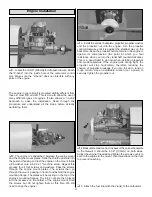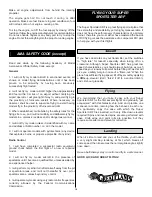
Make all engine adjustments from behind the rotating
propeller.
The engine gets hot! Do not touch it during or after
operation. Make sure fuel lines are in good condition so fuel
will not leak onto a hot engine, causing a fire.
To stop the engine, cut off the fuel supply by closing off the
fuel line or follow the engine manufacturer’s recommendations.
Do not use hands, fingers or any body part to try to stop the
engine. Do not throw anything into the prop of a running engine.
Read and abide by the following Academy of Model
Aeronautics Official Safety Code excerpt:
General
1. I will not fly my model aircraft in sanctioned events, air
shows, or model flying demonstrations until it has been
proven to be airworthy by having been previously
successfully flight tested.
2. I will not fly my model aircraft higher than approximately
400 feet within 3 miles of an airport without notifying the
airport operator. I will give right of way to, and avoid flying in
the proximity of, full-scale aircraft. Where necessary an
observer shall be used to supervise flying to avoid having
models fly in the proximity of full-scale aircraft.
3. Where established, I will abide by the safety rules for the
flying site I use, and I will not willfully and deliberately fly my
models in a careless, reckless and/or dangerous manner.
7. I will not fly my model unless it is identified with my name
and address or AMA number, on or in the model.
9. I will not operate models with pyrotechnics (any device
that explodes, burns, or propels a projectile of any kind).
Radio Control
1. I will have completed a successful radio equipment
ground check before the first flight of a new or repaired
model.
2. I will not fly my model aircraft in the presence of
spectators until I become a qualified flier, unless assisted by
an experienced helper.
3. I will perform my initial turn after takeoff away from the pit
or spectator areas, and I will not thereafter fly over pit or
spectator areas, unless beyond my control.
4. I will operate my model using only radio control frequencies
currently allowed by the Federal Communications
Commission.
The Super Sportster ARF is a great flying sport airplane that
flies smoothly and predictably, yet is highly maneuverable. It
does not have the self-recovery characteristics of a primary
trainer, therefore you must either have mastered the basics
of R/C flying or seek the assistance of a competent R/C pilot
to help you with your first flights.
If you have dual rates on your transmitter, set the switches
to “high rate” for takeoff, especially when taking off in a
crosswind. Although Super Sportster ARF has great low
speed characteristics, you should always build up as much
speed as your runway will permit before lifting off, as this will
give you a safety margin in case of a “flame-out.” When the
plane has sufficient flying speed, lift off by smoothly applying
a
little
up elevator (don’t “force” it off to a vertical climb!),
and climb out gradually.
We recommend that you take it easy with your Super
Sportster ARF for the first several flights and gradually “get
acquainted” with this fantastic ship. Add and practice one
maneuver at a time, learning how she behaves in each one.
We particularly enjoy the ease with which the Super
Sportster ARF flies inverted, with very little down elevator
required! Spins and inverted spins are also performed with
ease. Knife edge and point rolls are possible, but they
require some aileron and elevator correction.
When it’s time to land and you cut the throttle, you’ll notice
a very slight climbing tendency at first, which bleeds off
some speed; then it assumes the normal glide angle, slightly
nose down.
Have a ball! Always stay in control and fly in a safe manner.
GOOD LUCK AND GREAT FLYING!
Landing
Flying
Takeoff
FLYING YOUR SUPER
SPORTSTER ARF
AMA SAFETY CODE (excerpt)
19


































